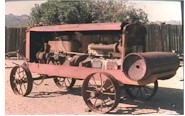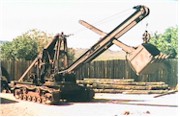![]()
..........At long last, this elusive pegmatite in western Maine has been re-discovered. Although many highly qualified prospectors and mineral enthusiasts have attempted to locate this site in the past, it remained buried in an accumulation of forest debris for almost three quarters of a century. The legend persisted, the search continued. Was there more to be found at the Perry Prospect than the brief reports of spodumene, petalite and heterosite indicated? In the Maine pegmatite belt, as in most world wide locations, lithia minerals are the key indicators for the much sought after and highly prized tourmaline. Would we ever know, or would these secrets remain buried along with Nate Perry, whose name is synonymous with so many of the early gem workings in Maine. Names that stir the very souls of mineral collectors, The Hatch Farm at Mt. Apatite in Auburn, - Tubb's Ledge, Norway, & Lord Hill, Stoneham to name just a few.
........We may soon know what treasures, if any, lie beneath the superficial surface
workings that were put in prior to Nate Perry's passing. With little more than a few
flimsy reports from the late 1800s and one from 1928, Cal Birtic of Pawtucket Rhode Island
managed to do what so many before him unsuccessfully attempted. Proving that perseverance,
common sense and a little hard work can bear fruitful results, he located the lost
prospect in June, 1997. It didn't take Cal long to form a partnership with his sometimes
prospecting buddy, Dick Dionne of Errol, New Hampshire. Together this dynamic duo
negotiated a lease for the property and pushed forward with their plans to commence mining
activities. Since both partners have been actively engaged in mining Maine pegmatites and
already had all the equipment needed for their intended purpose it wasn't too long before
they were able to begin developing the site. Their bulldozer/backhoe was the first piece
of equipment to reach the fabled mine and work immediately began to clear away the years
of debris that had accumulated in the small pit. The major problem facing the hopeful
miners was the lack of a passable road to haul fuel and supplies to the site. Building a
road was no easy task as there was no material available to use on it. What little mining
that had been done in the 1890s had left very little "mine grout" that most
mining roads are built up with. A compressor and dynamite magazines were moved to the top
of the hill with the aid of a skidder. Work on the road continued throughout the remainder
of the summer. After the dynamite magazines were inspected by the state fire Marshall's
office, a quick trip to Augusta and the necessary permits to use and store explosives were
obtained. With a sometimes passable road completed, (Ray Sprague of Emmon's Quarry fame,
refers to it as a "Goat Trail"), and no longer having to haul diesel and water
to  the top of the
hill by hand, the pace quickened. The miners, now anxious to see some results from all
their efforts, devised a plan of attack, so to speak, and soon the first holes were
drilled in the ledge, loaded and detonated. The dull roar of the explosives echoed from
the surrounding mountains and the unmistakable odor of "nitro" filled the air as
the two prospectors from their respective posts, one guarding the road to prevent unwary
visitors from straying into the blasting area, the other at the controls of the detonator,
with grins on their faces give the thumbs up signal to each other.
the top of the
hill by hand, the pace quickened. The miners, now anxious to see some results from all
their efforts, devised a plan of attack, so to speak, and soon the first holes were
drilled in the ledge, loaded and detonated. The dull roar of the explosives echoed from
the surrounding mountains and the unmistakable odor of "nitro" filled the air as
the two prospectors from their respective posts, one guarding the road to prevent unwary
visitors from straying into the blasting area, the other at the controls of the detonator,
with grins on their faces give the thumbs up signal to each other.
........ Nothing was recovered from these first benches as they were in barren granite pegmatite. This was part of the plan of attack and proved to be necessary so as to have some depth when the hoped for productive zone of the pegmatite was reached. After several more non productive benches the desired area was reached and what had previously been a gradual sloping ledge now had an eight foot high working face. The wall in front of them was suddenly awash in several shades of blue. Here was unaltered triphylite, blue albite and cleavelandite. Finally, the "Lost, Perry Petalite Prospect" is loosening it's grasp on the treasures that it has guarded for all these years. 1997 was a short but immensely rewarding season for the two miners. Operations ceased in early October, the equipment was winterized, the pit was allowed to fill with water and red ribbons were placed around the perimeter to prevent snowmobilers from unknowingly having the ground suddenly drop out from in front of them. Many minerals new to the locality were added to an ever growing list. Some are still awaiting identification. Quartz pseudomorphs of spodumene were common, perhaps the most exciting find, was cymatolite pseudos of spodumene, not that they in themselves are so important, but the fact that wherever cymatolite occurs in Maine there seems to be a very rich mineralogy associated with it. On the next page is a quartz pseudomorph of spodumene as it appeared in the quartz core. It was about two feet in length. The pseudo was covered with a greenish mica, the dark "window" had small diamond shaped muscovite books and tiny albite crystals lining the inside edges. Some of the more interesting phosphates recovered during this limited mining season were, hydroxylherderite, fluorapatite, autinite, and vivianite as micro crystals, jahnsite, triphylite, xanthoxenite & hetterosite.
..![]()
 |
 |
 |
![]() Click here for a photo journey from
discovery in 1997 through 1999 operations.
Click here for a photo journey from
discovery in 1997 through 1999 operations.
![]() Click here to return to The
Mineral Mall
Click here to return to The
Mineral Mall
Photos copyright © Dick Dionne 1998